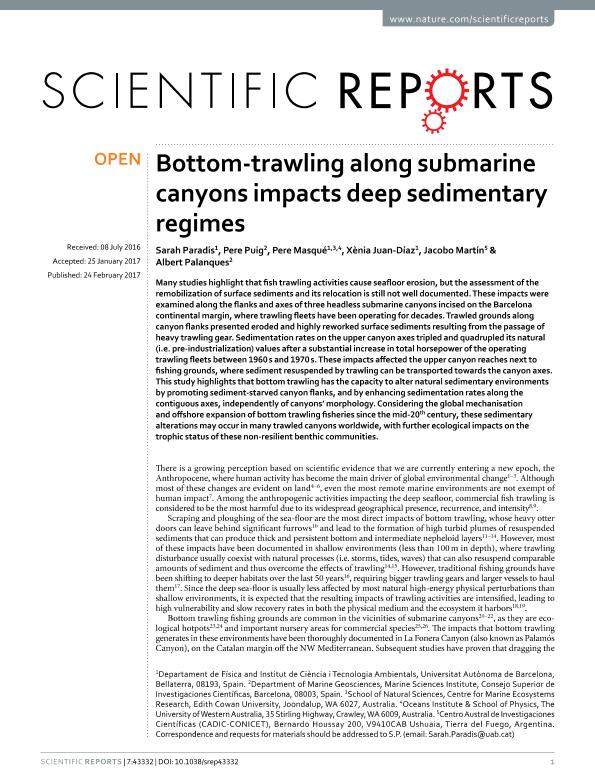Mostrar el registro sencillo del ítem
dc.contributor.author
Paradis, Sarah
dc.contributor.author
Puig, Pere
dc.contributor.author
Masqué, Pere
dc.contributor.author
Juan Diáz, Xènia
dc.contributor.author
Martín de Nascimento, Jacobo

dc.contributor.author
Palanques, Albert
dc.date.available
2018-10-31T16:05:03Z
dc.date.issued
2017-02-24
dc.identifier.citation
Paradis, Sarah; Puig, Pere; Masqué, Pere; Juan Diáz, Xènia; Martín de Nascimento, Jacobo; et al.; Bottom-trawling along submarine canyons impacts deep sedimentary regimes; Nature Publishing Group; Scientific Reports; 7; 24-2-2017; 1-12
dc.identifier.issn
2045-2322
dc.identifier.uri
http://hdl.handle.net/11336/63374
dc.description.abstract
Many studies highlight that fish trawling activities cause seafloor erosion, but the assessment of the remobilization of surface sediments and its relocation is still not well documented. These impacts were examined along the flanks and axes of three headless submarine canyons incised on the Barcelona continental margin, where trawling fleets have been operating for decades. Trawled grounds along canyon flanks presented eroded and highly reworked surface sediments resulting from the passage of heavy trawling gear. Sedimentation rates on the upper canyon axes tripled and quadrupled its natural (i.e. pre-industrialization) values after a substantial increase in total horsepower of the operating trawling fleets between 1960s and 1970s. These impacts affected the upper canyon reaches next to fishing grounds, where sediment resuspended by trawling can be transported towards the canyon axes. This study highlights that bottom trawling has the capacity to alter natural sedimentary environments by promoting sediment-starved canyon flanks, and by enhancing sedimentation rates along the contiguous axes, independently of canyons´ morphology. Considering the global mechanisation and offshore expansion of bottom trawling fisheries since the mid-20th century, these sedimentary alterations may occur in many trawled canyons worldwide, with further ecological impacts on the trophic status of these non-resilient benthic communities.
dc.format
application/pdf
dc.language.iso
eng
dc.publisher
Nature Publishing Group

dc.rights
info:eu-repo/semantics/openAccess
dc.rights.uri
https://creativecommons.org/licenses/by-nc-sa/2.5/ar/
dc.subject
Continental Margins
dc.subject
Submarine Canyons
dc.subject
Trawling
dc.subject.classification
Meteorología y Ciencias Atmosféricas

dc.subject.classification
Ciencias de la Tierra y relacionadas con el Medio Ambiente

dc.subject.classification
CIENCIAS NATURALES Y EXACTAS

dc.title
Bottom-trawling along submarine canyons impacts deep sedimentary regimes
dc.type
info:eu-repo/semantics/article
dc.type
info:ar-repo/semantics/artículo
dc.type
info:eu-repo/semantics/publishedVersion
dc.date.updated
2018-10-19T15:04:02Z
dc.journal.volume
7
dc.journal.pagination
1-12
dc.journal.pais
Reino Unido

dc.description.fil
Fil: Paradis, Sarah. Universitat Autònoma de Barcelona; España
dc.description.fil
Fil: Puig, Pere. Consejo Superior de Investigaciones Científicas. Instituto de Ciencias del Mar; España
dc.description.fil
Fil: Masqué, Pere. University of Western Australia; Australia. Universitat Autònoma de Barcelona; España. Edith Cowan University; Australia
dc.description.fil
Fil: Juan Diáz, Xènia. Universitat Autònoma de Barcelona; España
dc.description.fil
Fil: Martín de Nascimento, Jacobo. Consejo Nacional de Investigaciones Científicas y Técnicas. Centro Austral de Investigaciones Científicas; Argentina
dc.description.fil
Fil: Palanques, Albert. Consejo Superior de Investigaciones Científicas. Instituto de Ciencias del Mar; España
dc.journal.title
Scientific Reports
dc.relation.alternativeid
info:eu-repo/semantics/altIdentifier/doi/http://dx.doi.org/10.1038/srep43332
dc.relation.alternativeid
info:eu-repo/semantics/altIdentifier/url/https://www.nature.com/articles/srep43332
Archivos asociados
